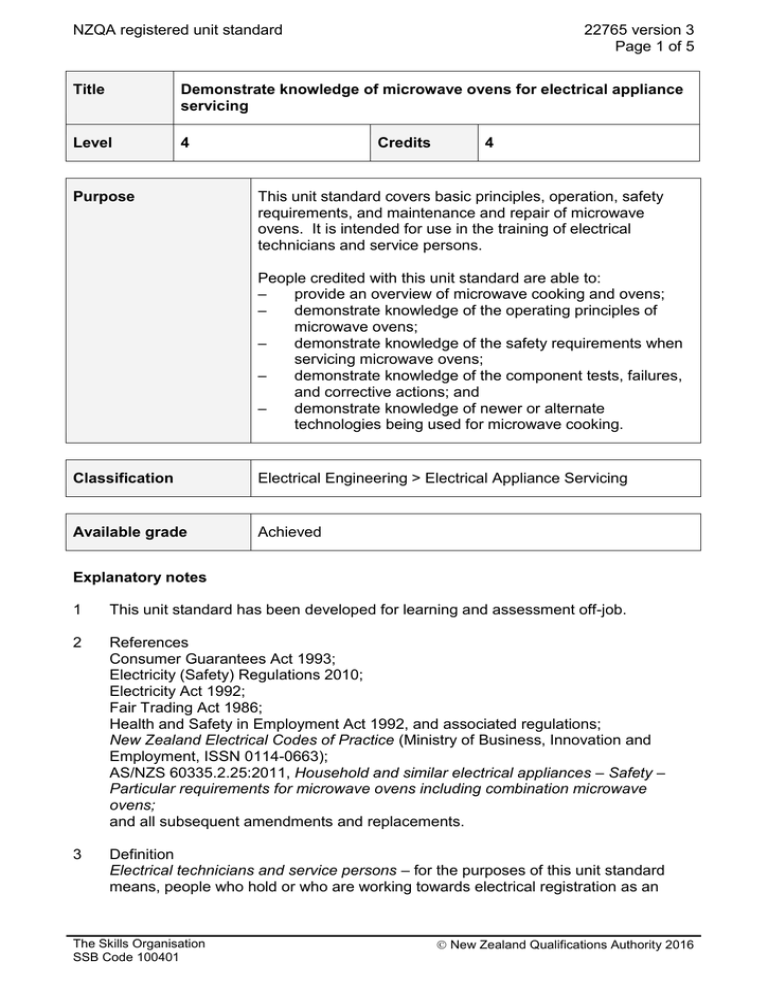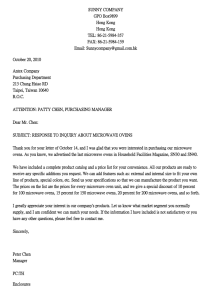NZQA registered unit standard 22765 version 3 Page 1 of 5
advertisement

NZQA registered unit standard 22765 version 3 Page 1 of 5 Title Demonstrate knowledge of microwave ovens for electrical appliance servicing Level 4 Purpose Credits 4 This unit standard covers basic principles, operation, safety requirements, and maintenance and repair of microwave ovens. It is intended for use in the training of electrical technicians and service persons. People credited with this unit standard are able to: – provide an overview of microwave cooking and ovens; – demonstrate knowledge of the operating principles of microwave ovens; – demonstrate knowledge of the safety requirements when servicing microwave ovens; – demonstrate knowledge of the component tests, failures, and corrective actions; and – demonstrate knowledge of newer or alternate technologies being used for microwave cooking. Classification Electrical Engineering > Electrical Appliance Servicing Available grade Achieved Explanatory notes 1 This unit standard has been developed for learning and assessment off-job. 2 References Consumer Guarantees Act 1993; Electricity (Safety) Regulations 2010; Electricity Act 1992; Fair Trading Act 1986; Health and Safety in Employment Act 1992, and associated regulations; New Zealand Electrical Codes of Practice (Ministry of Business, Innovation and Employment, ISSN 0114-0663); AS/NZS 60335.2.25:2011, Household and similar electrical appliances – Safety – Particular requirements for microwave ovens including combination microwave ovens; and all subsequent amendments and replacements. 3 Definition Electrical technicians and service persons – for the purposes of this unit standard means, people who hold or who are working towards electrical registration as an The Skills Organisation SSB Code 100401 New Zealand Qualifications Authority 2016 NZQA registered unit standard 22765 version 3 Page 2 of 5 Electrical Service Technician, Electrical Appliance Serviceperson (endorsed to disconnect and connect), or Electrical Appliance Serviceperson. 4 Range The range and depth of subject knowledge is such as to facilitate competent and safe electrical servicing of microwave ovens. Outcomes and evidence requirements Outcome 1 Provide an overview of microwave cooking and ovens. Evidence requirements 1.1 The basic principles of microwave energy are described with reference to ionizing and non-ionizing radiation, and frequency. 1.2 The process by which food is cooked by microwaves is described. Range 1.3 microwave penetration, proportional relationships, microwaves and metal. Safety considerations when cooking or using microwave ovens are described. Range arcing and back-feed, measurement of microwaves, safe levels of exposure, safety distances, pacemakers, radiation injuries, colour television emissions. Outcome 2 Demonstrate knowledge of the operating principles of microwave ovens. Evidence requirements 2.1 The operation of the high-voltage system of a typical microwave oven is described with the aid of sketches. Range 2.2 magnetron tube – effect of the magnetic field, resonant circuit, waveguide, Radio Frequency (RF) capacitors, cooling fins, phasing, life expectancy; transformers – high voltage transformer, filament transformer; high voltage circuit – high voltage capacitor and diode, half-wave voltage doubler, full-wave voltage doubler. The operation of the control systems of a typical microwave oven is described with reference to the primary circuit, subcircuits, components, and modules, and with the aid of sketches. Range The Skills Organisation SSB Code 100401 timers – pushbutton, electronic, glass touch panels, membrane switch panels; New Zealand Qualifications Authority 2016 NZQA registered unit standard 22765 version 3 Page 3 of 5 typical electronic control systems – generalised control panel circuit, control transformer, cook relay; processes – start up, holding and shutdown operation; start up, idle and cooking operation; secondary and subsidiary control, and components – output power control, primary side duty control (mechanical and solid state); triac drive circuit and system operation; secondary side duty control including varying of high-voltage potential, phase control, probe, humidity sensor, infrared sensor, convection cooking control. 2.3 The essential safety and protection circuits are described. Range 2.4 interlocking – switches and circuits, monitor switch, sequencing; protection devices – thermal, voltage (varistor, surge absorber, Positive Temperature Coefficient resistor), fuses, magnetron protection and failure detection. Microwave containment, cooling, and energy dispersion systems are described. Range containment – cooking cavity, cooking shelf, waveguide, door leakage safety; cooling and energy dispersion – cooling, stirrer, food rotation, energy dispersal, turntable, rotating antenna, stirrer and waveguide covers, baffles. Outcome 3 Demonstrate knowledge of the safety requirements when servicing microwave ovens. Evidence requirements 3.1 The principles, procedures, and use of instruments relating to testing for electrical safety are summarised with regard to the supply. Range test before touch, prove-test-prove, practices and limitations relating to the use of test instruments, checks to ensure isolation, means of ensuring that isolation is maintained. 3.2 The dangers of working with high voltage circuits are described, and means of ensuring safety are identified. 3.3 The possibility of RF exposure is identified, and preventative measures described. Outcome 4 Demonstrate knowledge of the component tests, failures, and corrective actions. The Skills Organisation SSB Code 100401 New Zealand Qualifications Authority 2016 NZQA registered unit standard 22765 version 3 Page 4 of 5 Evidence requirements 4.1 High voltage components tests are identified and described with reference to failure identification. Range 4.2 Control component and circuit tests are identified and described with reference to failure identification. Range 4.3 electromechanical, pushbutton and solid state timer checks and tests; low voltage transformer and transformer tests; warm-up delay and time delay circuit tests and checks, start-up, holding and shutdown relay tests; output power control testing; solid state controller, devices, modules and Triac tests and checks; temperature control probe testing; infrared sensor check; thermistor test. Safety and protection circuit tests are identified and described with reference to failure identification. Range 4.4 isolation test, power output check, magnetron plate current test, filament transformer voltage test, high voltage transformer test, high voltage capacitor test, diode check, half-wave rectifier test. door interlocks checks and adjustments, solenoid latch test, thermal protection tests, ferrite isolator test, surge monitor system check, voltage protection device tests, supply and supply fuses tests. Containment, cooling, and energy dispersion checks are identified and described with reference to failure identification. Range choke cavity clean, cooking cavity clear of rust, corrosion damage to metal or painted surfaces, waveguide disorders, door leakage and safety, adjustment on door correct, blower motor test, microwave heat distribution test, stirrer or antenna rotation verified, stirrer and waveguide covers in place and complete, grease and spatter shield clean and in place. Outcome 5 Demonstrate knowledge of newer or alternate technologies being used for microwave cooking. Evidence requirements 5.1 The additional requirements needed for the convection option in a microwave oven are described. Range The Skills Organisation SSB Code 100401 heating elements, power circuits, control circuits, structural or mechanical requirements. New Zealand Qualifications Authority 2016 NZQA registered unit standard 5.2 22765 version 3 Page 5 of 5 A brief overview of new technology in relation to bench top cooking is provided. Range inverter technology, cooking with light (halogen light source converted to microwave), magnetic induction as an alternative, touch screen control built into microwave oven doors – including internet ready connection. Planned review date 31 December 2014 Status information and last date for assessment for superseded versions Process Version Date Last Date for Assessment Registration 1 20 June 2006 N/A Rollover and Revision 2 20 September 2012 N/A Revision 3 15 January 2014 N/A Consent and Moderation Requirements (CMR) reference 0003 This CMR can be accessed at http://www.nzqa.govt.nz/framework/search/index.do. Please note Providers must be granted consent to assess against standards (accredited) by NZQA, before they can report credits from assessment against unit standards or deliver courses of study leading to that assessment. Industry Training Organisations must be granted consent to assess against standards by NZQA before they can register credits from assessment against unit standards. Providers and Industry Training Organisations, which have been granted consent and which are assessing against unit standards must engage with the moderation system that applies to those standards. Requirements for consent to assess and an outline of the moderation system that applies to this standard are outlined in the Consent and Moderation Requirements (CMR). The CMR also includes useful information about special requirements for organisations wishing to develop education and training programmes, such as minimum qualifications for tutors and assessors, and special resource requirements. Comments on this unit standard Please contact The Skills Organisation reviewcomments@skills.org.nz if you wish to suggest changes to the content of this unit standard. The Skills Organisation SSB Code 100401 New Zealand Qualifications Authority 2016




